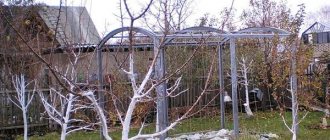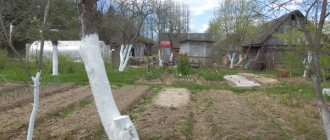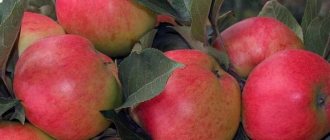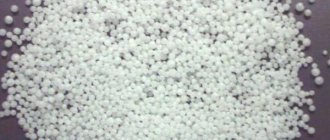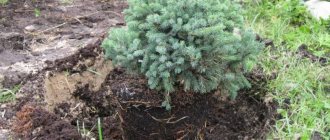What problems does moisture-charging irrigation solve in the fall?
The main task of moisture-charging irrigation is to wet the root system of plants as best as possible so that the winter goes well for them. After all, in winter, despite the dormant period, moisture from the trees evaporates anyway. And if the trees are not saturated with enough moisture, severe frosts literally dry out the trunks, branches and needles.
We saturate plants with water for future use in order to:
- replenish summer moisture loss,
- prevent drying of trunks and shoots of deciduous plants, since moisture evaporates from the bark in winter,
- help avoid yellowing of coniferous plants in the spring - evaporation in winter also occurs from the surface of the needles,
- protect the roots from winter frosts: the moist lump that forms around the roots remains warm much longer,
- guarantee good plant growth in the spring of the new year,
- protect flower buds from freezing.
When to water trees in the fall? You need to wait for the plants to enter a dormant state: at least half of the foliage of deciduous plants should be shed.
No matter what watering is convenient for you, it is important to do everything in moderation and not overdo it.
When completing watering, do not forget to check the depth to which the soil is wet. If there is more moisture than required, the soil will not be able to pass air. Since air permeability primarily affects the roots, the lack of sufficient oxygen can cause the death of the plant.
Autumn and pre-winter watering should be excluded in areas that are located close to groundwater and in areas with poor drainage. In the case of southern regions, it is recommended not to flood the soil with water for the winter. This is explained by the presence of a mild climate, the soil in these areas does not freeze and the roots continue their vital activity even in winter.
Norms for autumn watering of trees
Many people believe that watering trees in the fall is just regular watering and 7 buckets are enough for one adult plant. In reality there should be a lot of water. The ground should get wet by 50-60 cm, and for large plants by 80-100 cm.
The calculation of water is simple and the same for all plants - fruit, coniferous, and decorative deciduous:
- 3 buckets are enough for young 1-3 year old trees and shrubs.
- 7 buckets are required for older plants - aged 4-10 years.
- 10 buckets are needed for adult shrubs (over 10 years old).
- We pour 12 buckets under mature trees (over 10 years old).
It is advisable to extend watering 2-3 times so that the water is absorbed into the soil and does not spread over the area. Take a break of 1-2 days between waterings.
When to water?
Autumn is usually rainy. Drizzling rain gives way to downpours and sleet. But at the depth of the roots of most fruit trees and shrubs, the earth remains dry. Only the top layer of soil is wetted.
It is during this period that gardeners have to determine the timing of autumn moisture-recharging (moisture-recharging) irrigation. It is more correct to carry it out when most of the foliage has fallen. But this is prevented by a whole list of circumstances. Not everyone has the opportunity to come to their suburban area in late autumn. The hoses were also removed before the water in them froze. In some collective gardens, summer water supplies are turned off for the winter. I know people who have to carry buckets of water from village wells to water their trees in the pre-winter period.
It is impossible to name the exact dates for autumn watering of the garden. We are all accustomed to the fact that winter always begins unexpectedly. I remember how once, in one week before November 3, a lot of snow fell and the water on the Ivankovskoye Reservoir (Moscow Sea) froze. Another year, around the same time, I picked ripe tomatoes in a greenhouse. It happened that in October the lungwort bloomed again, the lilac blossomed, and the honeysuckle buds appeared. These facts confirm the unpredictability of our climate.
More and more often, trees go into winter with leaves, so you shouldn’t focus on leaf fall. Watering too early in autumn risks the growth of young shoots that may freeze. But this is the lesser of all the evils that will inevitably affect frosty winters with little snow and without proper autumn watering. I usually carry out moisture-recharging (moisture-recharging) irrigation in October - November. In several periods of time, allowing not only not to create a swamp on the site, but also to better saturate the ground under the trees and shrubs.
Rules for moisture-charging watering of trees
You can water with buckets. This is the easiest way to follow the norm. But what to do if there is a long distance from the water source to the plant or the tree is huge?
We use a garden hose.
First, measure how long it takes to fill a 10-liter bucket from a hose. For example, a bucket is filled in 20 seconds, a plant needs 10 buckets, which means we water with a hose for 3 minutes 20 seconds. This way you won't be mistaken about how much water is poured under the tree.
It is not recommended to pour water on a tree trunk or near the trunk (this is especially true for stone fruits that are prone to rotting: cherries, plums, etc.). The optimal distance from the trunk is 15 centimeters.
After watering, the plant can be mulched with dry peat or bark.
Moisture-charging irrigation can be combined with the application of phosphorus-potassium fertilizers. They will help the trees to winter well and will contribute to the formation of a good future harvest.
How to water?
I don’t like the option with pipes dug into the ground through which the plants are watered. I place the hose on the ground under the tree and let the water run. From time to time I move it to another place. On the cultivated loam of my site, you can do without a sprinkler. It has to be used on sands, because... all the water flows almost vertically into the depths.
It is impossible to direct the jet at a tree trunk; this is fraught with many further problems. The main irrigation zone is the crown projection.
It is better to moisten garden strawberries using a watering can. Under currants, gooseberries and raspberries, the soil is so loose that a stream of water often creates funnels. They have to be leveled immediately.
Autumn watering of currant and gooseberry bushes
It is believed that areas with heavy clay do not need autumn watering. However, it was he who saved many fruit trees that suffered during the frosty winter of 1986-1987. By the end of December, little snow had fallen and the air temperature dropped below 30°C. My parents' dacha (Moscow region, Riga direction) was located on a small slope, behind which there was a pond and a forest. The soil is solid cold clay. During that frosty winter, the fruit trees “crackled” terribly at night. In the spring, it turned out that almost all of our trees and most of our neighbors had frozen out. Those that survived were the ones under which a lot of water was poured in the fall.
On Central Television and in regional newspapers it was recommended to water the frozen soil in small portions in December so that the most valuable varieties of fruit trees receive at least 50 liters of water for each square meter of land under their crown. Some severely frostbitten trees were saved in early spring. They had to be “cast”, i.e. Water vigorously and then loosen the soil underneath. This method also helped the bushes that gave new shoots.
Watering seedlings in autumn
A very important point. If you do not carry out water-recharging irrigation for newly purchased and planted plants, you can pay for it. The seedlings may simply not take root. It would seem like a young seedling (literally a couple of branches), but you also need to pour 30-40 liters of water under it. And that's why.
First, the soil particles will adhere tightly to the roots, and the roots will function normally in the future. Secondly, the seedling, which may be threatened by frost, will overwinter well due to such deep, good watering.
Remember: moisture-recharging watering is one of the main activities when caring for plants in the fall. It must be done every year. And don't worry: a wet plant won't freeze!
Water your plants in the fall, and they will enter winter hydrated, strong, and ready for the challenges of winter and spring.
When should water-recharging irrigation be carried out?
In the Moscow region and the middle zone, the garden begins to be watered for the winter in mid-October - early November. At this time, dry and sunny weather sets in, although without much heat. In Siberia and the Urals, moisture-recharging irrigation is carried out at the end of September. Many people combine draining water from pipes and ponds (decorative reservoirs) with moisture-recharging irrigation.
If the plants did not have enough water during the season and the summer was dry, it is better to delay watering for one or two weeks, otherwise the plants may bloom.
To carry out water-recharging irrigation, wait until the leaves fall.
Pouring trees for the winter. Autumn preparation of fruit trees for winter
When the summer season comes to an end, the main task of gardeners is to prepare plants for winter.
We'll tell you what needs to be done with fruit trees so that they can easily withstand the cold. In October, when the main work in the flower beds and beds has been completed, it’s time to take care of the bushes and trees. The harvest next year depends on how they survive the coming winter.
How to prune trees and bushes correctly
There is not much time for preparatory work; this is the period from the first leaf fall to the beginning of prolonged frosts. Plant pruning should not be carried out during frosts, because the cold makes the wood brittle and branches may break during the procedure. The cracks will deepen over the winter, the cut points can easily become infected, and in the spring there will be a high risk of tree disease.
The following are subject to removal:
- diseased, broken and dry branches;
- far protruding branches;
- branches inside the crown that thicken it and interfere with each other.
In shrubs, in addition, root shoots and shoots are removed. If you decide to prune raspberries, do not delay - it is better to do it before the end of October. The shoots that have grown this year must be carefully bent to the ground, strengthened and covered before wintering. After removing excess branches, the cuts must be smooth so that the bark does not lift up. If this happens, the cut site is cleared of sawdust or wood chips and treated with a 2% solution of copper sulfate. All debris after pruning is burned; only healthy branches are taken for compost.
What preventative treatment is required for garden trees
When pruning, you need to carefully inspect the main trunk and the largest branches that form the crown. There should be no pests in the cracks of the bark: weevils, moths, scale insects hiding for the winter. When the first frosts pass, it is recommended to treat the crowns of pear and apple trees. The solution is prepared at the rate of 50 g of urea per 1 liter of water. At the end of October, stone fruit trees are treated with a 3% solution of Bordeaux mixture.
Why is autumn whitewashing preferable?
As a rule, tree trunks are whitened in the spring to protect them from infection and pests. Autumn whitewashing has its advantages over spring whitewashing. It will also protect the trunk from temperature fluctuations in winter and early spring, and will save it from the burning spring sun.
To prepare a whitewash solution, take:
- up to 3 kg of freshly slaked lime;
- 10 liters of cold water;
- 1 kg of unhardened clay.
All ingredients are mixed. The addition of clay is necessary for better adhesion of the whitewash to the trunk, which is coated to a height of at least 1 m.
Why are waterings needed and how are they carried out?
Watering trees in October is necessary to protect their root system from frost. Young and non-fruit-bearing trees are watered along the circumference of the trunk circle, and mature trees that have already bear fruit are watered along the circumference of the crown. It is important not to wet the trunk. It is necessary to maintain the norm for 1 tree. It is taken at the rate of up to 50 liters of water per 1 sq.m. Watering is carried out in small portions (no more than 20 liters) every 2 hours until the water is completely absorbed into the ground. It is completed if, within 30 minutes after watering, the top layer of soil retains the consistency of thick sour cream. After this, the tree trunk circles are mulched. This work will not require a lot of time, effort and material costs. If done in a timely and careful manner, they will help fruit trees and shrubs survive the winter and enjoy a good harvest next season.
